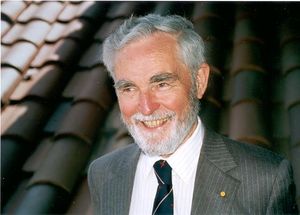Ronald N. Bracewell: Difference between revisions
(Created page with "== Biography == Ronald N. Bracewell was born on July 22, 1921 in Sydney, Australia. He is best known for his work with radio telescopes. Bracewell joined the electrical engineer...") |
No edit summary |
||
| Line 1: | Line 1: | ||
== Biography == | == Biography == | ||
Ronald N. Bracewell | [[Image:Ronald N. Bracewell 2527.jpg|thumb|right]] | ||
Bracewell authored many publications, including two textbooks, ''Radio Astronomy'' (1955) and ''The Fourier Transform and Its Applications'' (1965), and ''Trees of Stanford and Environs'' (2005). He became a professor emeritus of electrical engineering at Stanford in 1991, and won the IEEE Heinrich Hertz Medal in 1994. He died on August 12, 2007 at his home in Stanford, California. | Ronald N. Bracewell was born on July 22, 1921 in Sydney, Australia. He is best known for his work with [[Radio Telescope|radio telescopes]]. Bracewell joined the electrical engineering faculty at Stanford in 1955. Here he, along with his colleagues, designed a specialized radio telescope, known as a spectroheliograph. This device was able to both receive and evaluate the Sun's microwaves. In the 1960s, Bracewell used the specialized telescope to create maps, which helped to predict solar storms. In the 1970s, scientists employed Bracewell's research in radio astronomy in the development of various forms of medical imaging, such as the x-ray imaging of tumors, known as tomography. | ||
Bracewell authored many publications, including two textbooks, ''Radio Astronomy'' (1955) and ''The Fourier Transform and Its Applications'' (1965), and ''Trees of Stanford and Environs'' (2005). He became a professor emeritus of electrical engineering at Stanford in 1991, and won the [[IEEE Heinrich Hertz Medal|IEEE Heinrich Hertz Medal]] in 1994. He died on August 12, 2007 at his home in Stanford, California. | |||
{{DEFAULTSORT:Bracewell}} | |||
[[Category:Communications]] | |||
[[Category:Radio_communication]] | |||
Revision as of 13:47, 10 September 2013
Biography
Ronald N. Bracewell was born on July 22, 1921 in Sydney, Australia. He is best known for his work with radio telescopes. Bracewell joined the electrical engineering faculty at Stanford in 1955. Here he, along with his colleagues, designed a specialized radio telescope, known as a spectroheliograph. This device was able to both receive and evaluate the Sun's microwaves. In the 1960s, Bracewell used the specialized telescope to create maps, which helped to predict solar storms. In the 1970s, scientists employed Bracewell's research in radio astronomy in the development of various forms of medical imaging, such as the x-ray imaging of tumors, known as tomography.
Bracewell authored many publications, including two textbooks, Radio Astronomy (1955) and The Fourier Transform and Its Applications (1965), and Trees of Stanford and Environs (2005). He became a professor emeritus of electrical engineering at Stanford in 1991, and won the IEEE Heinrich Hertz Medal in 1994. He died on August 12, 2007 at his home in Stanford, California.
